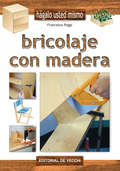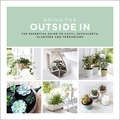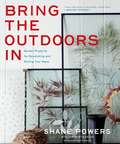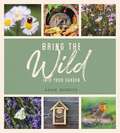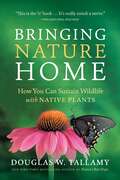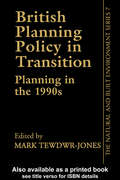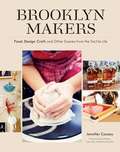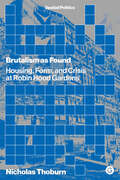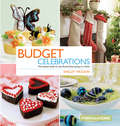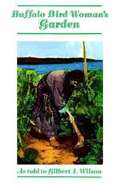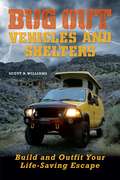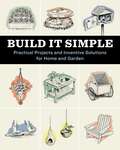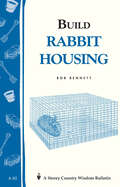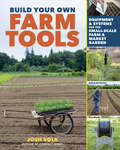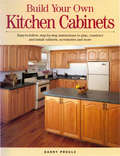- Table View
- List View
Brewing with Hemp: The Essential Guide (Brewing with Cannabis)
by Ross KoenigsBrewing with Hemp: The Essential Guide explores the Cannabis sativa plant from a brewer&’s perspective. Explore the role of foliage and flowers, seeds, fiber, stems, and roots in product development. Learn the science, methods, and techniques for infusing hemp (containing less than 0.3% THC), hemp flavors, and cannabinoids into beverages. Solubilizing shelf stable cannabinoids in beverages, hemp additions at traditional brewing stages, and quality and legal compliance are all discussed. This book navigates the science of cannabis and teaches brewers how to best use hemp to apply its unique aromas to beer. Discover the use of terpenes, create a tincture, or experiment with new recipes using hemp as an ingredient. Readers will learn how to navigate the shifting legal landscape as hemp becomes more acceptable and accessible. This forward-looking book weaves together familiar topics within the study of beer and brewing and applies it to the vast and fascinating world of hemp as an ingredient in beer.
Brickwork: v.2
by Gerard C.J. LynchThis series of books offers an in depth guide to all aspects of brickwork and bricklaying practice. Gerard Lynch, author of the guide to "Guaged Brickwork", has put together these comprehensive and instructive volumes, linking past knowledge and practices with modern skills and materials, so that both can be fully examined and understood. At a time when the conservation and restoration of old buildings demand a more sympathetic handling, such a work should be a useful addition to the existing literature, and an essential source of reference for all those involved in the construction and repair of brick buildings. The second of six volumes which offer an in-depth guide to all aspects of brickwork and bricklaying practice, this volume examines the elements of building construction in brick. The text covers both the contemporary and traditional aspects of substructure brickwork. Chapter one studies the setting out of a small building, and then progresses to foundations, examining the historical, as well as current practices, along with information on modern concrete production. The following six chapters cover both the contemporary and traditional aspects of substructure brickwork, basements, sleeper walls, damp proof courses, cavity walling, and jointing and pointing. The volume concludes with useful advice on achieving controlled and efficient bricklaying.
Bricolaje con madera
by Francesco Poggi* Todos los aficionados a los trabajos con la madera, un material cálido y natural, encontrarán en este libro las indicaciones necesarias para conocer las características de las maderas más comunes. * En esta obra, el lector aprenderá todos aquellos conocimientos imprescindibles que necesita para realizar con éxito trabajos de bricolaje con madera en casa, desde arreglar desperfectos en sus muebles hasta construirse aquellos objetos que desee. * Las herramientas necesarias, los diferentes tipos de corte, las operaciones de lijado, encolado, realización de ensambles y aplicación de los distintos acabados con la misma calidad que lo hubiera hecho un profesional. * Toda la información que necesita para construir con sus propias manos sillas, mesas, jardineras, cajoneras, bancos de trabajo y muchos otros objetos necesarios para la casa.
Bring The Outside In: The Essential Guide to Cacti, Succulents, Planters and Terrariums
by Val Bradley_____________"Everything you need to know about keeping plants in your house... lovely pictures, tips, tricks... I love it." (Zoe Sugg a.k.a Zoella)Love plants, but short on outdoor space? Keen to fill your home with greenery but don't know where to start? Or perhaps you've been labelled a house-plant serial killer? Then this is the book for you.With stunning photography and expert step-by-step tips, Bring The Outside In reveals everything you need to know to help your plants thrive, from dramatic statement foliage and miniature citrus trees to table-top terrariums and hanging planters. With chapters on orchids, cacti, herb gardens and chilli plants, your home will be flourishing in no time.
Bring the Outdoors In
by Jennifer Cegielski Shane PowersNothing enlivens a room like a touch of nature. Taking the terrarium trend to the next level, this stunning guide will inspire crafters, garden lovers, and décor fans to turn flowers, leaves, and branches into striking, organic décor. Acclaimed designer and stylist Shane Powers presents 20 simple yet arresting projects for bringing natural tranquility to any space. Suited for garden enthusiasts and black thumbs alike, the projects use a range of live and dried plant materials to create colorful dried floral garlands, eye-catching willow wreaths, intriguing water gardens, and timeless succulent landscapes. With step-by-step instructions, styling and container ideas, helpful resources, and gorgeous photography, Bring the Outdoors In offers countless ways to welcome the natural world into any space.
Bring the Wild into Your Garden: Simple Tips for Creating a Wildlife Haven
by Annie BurdickShow nature the kindness it deservesWhether you long to see butterflies flit across your flowerbeds or hear birdsong all year round, there’s something endlessly rewarding about playing host to wildlife. With practical projects and helpful tips for gardens big and small, this guide will help boost local biodiversity and benefit countless native species. Learn how to:Choose the best type of bird feeder and seed for your feathered friendsBuild natural habitats and provide shelter for all manner of insectsMake sugaring recipes to attract butterflies and mothsSelect the right pollinator plants for bees in every seasonWherever you do it – on a balcony, in a garden or across acres of land – you too can create the perfect sanctuary for an abundance of creatures.
Bringing Nature Home: How Native Plants Sustain Wildlife In Our Gardens
by Douglas W. TallamyBy growing native plants, suburban gardeners can play an important role in helping create sustainable ecosystems. Believing that knowledge will generate interest in being part of the solution, Tallamy (entomology and wildlife ecology, U. of Delaware in Newark) explains why biodiversity is crucial and what to plant to encourage beneficial insects. The gently persuasive book includes color photos; a listing of landscape-worthy, wildlife-attracting native plants by U. S. region; summary table of host plants of butterflies and showy moths; and experimental evidence for the ability of native as vs. alien plants to attract beneficial insects. Annotation ©2008 Book News, Inc. , Portland, OR (booknews. com)
Bringing Nature Home: How You Can Sustain Wildlife With Native Plants
by Douglas W. TallamyThe pressures on wildlife populations today are greater than they have ever been and many gardeners assume they can remedy this situation by simply planting a variety of flowering perennials, trees, and shrubs. As Douglas Tallamy points out in this revelatory book, that assumption is largely mistaken. Wild creatures exist in a complex web of interrelationships, and often require different kinds of food at different stages of their development. There is an unbreakable link between native plant species and native wildlife. When native plant species disappear, the insects disappear, thus impoverishing the food source for birds and other animals. Fortunately, there is still time to reverse this alarming trend, and gardeners have the power to make a significant contribution toward sustainable biodiversity. By favoring native plants, gardeners can provide a welcoming environment for wildlife of all kinds. Healthy local ecosystems are not only beautiful and fascinating, they are also essential to human well-being. By heeding Douglas Tallamy's eloquent arguments and acting upon his recommendations, gardeners everywhere can make a difference.
Bringing Nature Home: How You Can Sustain Wildlife with Native Plants, Updated and Expanded
by Douglas W. Tallamy Rick Darke“If you cut down the goldenrod, the wild black cherry, the milkweed and other natives, you eliminate the larvae, and starve the birds. This simple revelation about the food web—and it is an intricate web, not a chain—is the driving force in Bringing Nature Home.” —The New York Times As development and subsequent habitat destruction accelerate, there are increasing pressures on wildlife populations. But there is an important and simple step toward reversing this alarming trend: Everyone with access to a patch of earth can make a significant contribution toward sustaining biodiversity. There is an unbreakable link between native plant species and native wildlife—native insects cannot, or will not, eat alien plants. When native plants disappear, the insects disappear, impoverishing the food source for birds and other animals. In many parts of the world, habitat destruction has been so extensive that local wildlife is in crisis and may be headed toward extinction.Bringing Nature Home has sparked a national conversation about the link between healthy local ecosystems and human well-being, and the new paperback edition—with an expanded resource section and updated photos—will help broaden the movement. By acting on Douglas Tallamy's practical recommendations, everyone can make a difference.
Britain's New Towns: Garden Cities to Sustainable Communities
by Anthony AlexanderThe New Towns Programme of 1946 to 1970 was one of the most substantial periods of urban development in Britain. The New Towns have often been described as a social experiment; so what has this experiment proved? This book covers the story of how these towns came to be built, how they aged, and the challenges and opportunities they now face as they begin phases of renewal. The new approaches in design throughout their past development reflect changes in society throughout the latter half of the twentieth century. These changes are now at the heart of the challenge of sustainable development. The New Towns provide lessons for social, economic and environmental sustainability. These lessons are of great relevance for the regeneration of twentieth century urbanism and the creation of new urban developments today.
British Gardens in Time: The Greatest Garden Makers from Capability Brown to Christopher Lloyd
by Katie CampbellAs seen on BBC: An illustrated visit to four iconic gardens, each a product of its age, with stories of the creators and events that shaped them.The stories of these gardens’ creation include obsession, escape, social ambition, political intrigue, heartbreak, bankruptcy, and disaster. In unravelling these remarkable stories we reach back over the centuries to see these great gardens through fresh eyes.From the magnificent landscape garden at Stowe created by Bridgeman, Kent and Lancelot ‘Capability’ Brown; the Victorian masterpiece of Biddulph Grange; the romantic Arts & Crafts retreat at Nymans; and Christopher Lloyd’s plantsman’s paradise at Great Dixter, you will hear of adventure, innovation, and visionary individuals who changed the way we create our gardens and the plants we grow. Katie Campbell weaves the stories of these four exemplary gardens into a history of British gardening from the earliest cultivated spaces to the present day, exploring trends, influences, and pioneers. Fascinating historic detail and atmospheric storytelling make this a compelling read.Includes a foreword by Chris Beardshaw, specially commissioned photography by Nathan Harrison, and extensive archive illustrations “A worthy accompaniment to the BBC series of the same name.” —The Irish Times“Campbell treads a nice line between juicy facts and the aesthetic qualities of the gardens. I adore her description of Jane Austen-ish tourists turning up in carriages, buying guidebooks and filling up the local inns, while commendably tipping the head gardener.” —The Independent
British Planning Policy: Planning In The Major Years
by Mark Tewdwr-JonesFirst Published in 1995. Routledge is an imprint of Taylor & Francis, an informa company.
Brooklyn Makers
by Jennifer CauseyA creative renaissance blooms in Brooklyn. At its heart is a thriving community of artisans producing a remarkable variety of handmade goods. In Brooklyn Makers, photographer Jennifer Causey captures the spirit of this homegrown movement by documenting thirty of the borough's most celebrated craftsmen. This eclectic mix of established and up-and-coming makers includes bakers, ceramic artists, clothing designers, florists, distillers, and more. With an eye for small details, Causey's charming photographs reveal each artisan at work in their own space. Her lively interviews reveal what inspires them, keeps them motivated, and their thoughts on the city where they live and work.
Brutalism as Found: Housing, Form, and Crisis at Robin Hood Gardens (Spatial Politics)
by Nicholas ThoburnA critical appropriation of Brutalism in the crisis conditions of today.The Robin Hood Gardens public-housing estate in East London, completed in 1972, was designed by Alison and Peter Smithson as an ethical and aesthetic encounter with the flux and crises of the social world. Now demolished by the forces of speculative development, this Brutalist estate has been the subject of much dispute. But the clichéd terms of debate—a &“concrete monstrosity&” or a &“modernist masterpiece&”—have marginalized the estate&’s residents and obscured its architectural originality. Recovering the social in the architectural, this book centers the estate&’s lived experience of a multiracial working class, not to displace the architecture&’s sensory qualities of matter and form, but to radicalize them for our present.Immersed in the materials, atmospheres, social forms and afterlives of this experimental estate, Robin Hood Gardens is reconstructed here as a socio-architectural expression of our times out of joint.
Budget Celebrations: The Hostess Guide to Year-Round Entertaining on a Dime
by Shelley WolsonThis all-in-one guide is the ultimate resource for stress-free, budget-friendly entertaining for every special occasion. This collection of more than 250 inspiring photos and easy-to-follow instructions shows how to have a good time without breaking the bank.
Buffalo Bird Womans Garden: Agriculture of the Hidatsa Indians
by Jeffery R. Hanson Gilbert L. WilsonFrom the book: Buffalo Bird Woman, known in Hidatsa as Maxidiwiac, was born about 1839 in an earth lodge along the Knife River in present-day North Dakota. In 1845 her people moved upstream and built Like-a-fishhook village, which they shared with the Mandan and Arikara. There Buffalo Bird Woman grew up to become an expert gardener of the Hidatsa tribe. Using agricultural practices centuries old, she and the women of her family grew corn, beans, squash, and sunflowers in the fertile bottomlands of the Missouri River. In the mid-1880s, U.S. government policies forced the break up of Like-a-fishhook village and the dispersal of Indian families onto individual allotments on the Fort Berthold Reservation, but Hidatsa women continued to grow the vegetables that have provided Midwestern farmers some of their most important crops. In Buffalo Bird Woman's Garden, first published in 1917 as Agriculture of the Hidatsa Indians: An Indian Interpretation, anthropologist Gilbert L. Wilson transcribed in meticulous detail the knowledge given by this consummate gardener. Following an annual round, Buffalo Bird Woman describes field care and preparation, planting, harvesting, processing, and storing of vegetables. In addition, she provides recipes for cooking traditional Hidatsa dishes and recounts songs and ceremonies that were essential to a good harvest. Her first-person narrative provides today's gardener with a guide to an agricultural method free from fertilizers, pesticides, and herbicides. ... Squash Dolls There is one other thing I will tell before we forsake the subject of squashes. Little girls of ten or eleven years of age used to make dolls of squashes. When the squashes were brought in from the field, the little girls would go to the pile and pick out squashes that were proper for dolls. I have done so, myself. We used to pick out the long ones that were parti-colored; squashes whose tops were white or yellow and the bottoms of some other color. We put no decorations on these squashes that we had for dolls. Each little girl carried her squash about in her arms and sang for it as for a babe. Often she carried it on her back, in her calf skin robe. ... This is a most fascinating read whether or not one likes to garden.
Bug Out Vehicles and Shelters: Build and Outfit Your Life-Saving Escape
by Scott B. WilliamsA CATACLYSMIC DISASTER STRIKES YOUR AREA.How will you evacuate your family to safety?Do you have a vehicle you can count on?Can it double as a mobile retreat, or do youhave a shelter prepared in advance?What's your plan for reaching the shelter?Bug Out Vehicles and Shelters gives you the vital answers and options for becoming a survivor instead of a refugee:VEHICLES Prepping fast-escape vehicles Using specially equipped vehicles for unique situations Planning for backup vehicles if your main escape option fails Utilizing bikes, canoes, kayaks, rowboats and other human-powered means of escapeSHELTERS Preparing temporary shelters Locating and stocking longterm shelters Using an RV, motorhome, camper trailer or converted utility vehicle Living aboard boats, from motorboats to houseboats to blue-water sailboatsExplaining the advantages and drawbacks of each vehicle and shelter option, this survival handbook zeroes in on the key considerations and essential equipment for planning all your bug-out needs.
Bug-Free Organic Gardening: Controlling Pest Insects Without Chemicals
by Anna HessPut down those harmful sprays and learn natural pest control! Are you sick and tired of pesky insects in your garden? Do you want to stay away from pesticides and harmful poisons that could be hazardous to your health and your garden? If you answered yes to both of those questions, Bug-Free Organic Gardening has all the answers to your troubles. This book will show you how to bring your garden ecosystem into balance so that beneficial insects and larger animals do the work of pest control for you. Anna Hess has more than a decade’s experience growing all of her family’s vegetables. Here, she sums up all of her knowledge and expertise, teaching you many hands-on pest-control techniques, such as: Succession plantingChoosing resistant plant varietiesShielding plants with row coversTiming plantings to bypass bugsAnd so much more! With Anna’s expertise, you too can grow beautiful, healthy, organic vegetables for yourself and your family, put down those harmful sprays, and learn natural pest control!
Build It Simple: Practical Projects and Inventive Solutions for Home and Garden
by How-To Experts at Storey PublishingDiscover 50 simple, thrifty, low-tech projects that you can create, even if you're a novice builder! With simple tools and materials and just basic building skills, you can make exactly what you need for all of your backyard and gardening projects, from a tool shed and storage bins to lawn chairs, fences, plant supports, and feeders for your chickens. These sustainable, timeless designs, paired with step-by-step instructions and resourceful tips provide a wealth of ideas for a practical and purposeful garden and home. This publication conforms to the EPUB Accessibility specification at WCAG 2.0 Level AA.
Build Rabbit Housing: Storey Country Wisdom Bulletin A-82 (Storey Country Wisdom Bulletin Ser.)
by Bob BennettSince 1973, Storey's Country Wisdom Bulletins have offered practical, hands-on instructions designed to help readers master dozens of country living skills quickly and easily. There are now more than 170 titles in this series, and their remarkable popularity reflects the common desire of country and city dwellers alike to cultivate personal independence in everyday life.
Build Your Own Beekeeping Equipment: How to Construct 8- & 10-Frame Hives; Top Bar, Nuc & Demo Hives; Feeders, Swarm Catchers & More
by Tony PisanoSave time and money by building your own beekeeping equipment. Learn to craft equipment that is tailored to your particular climate and setup. Full of insightful tips and covering a variety of hive types, Pisano includes all the basic infrastructure you need to keep your bees happy and active — and your pantry full of honey.
Build Your Own Farm Tools: Equipment & Systems for the Small-Scale Farm & Market Garden
by Josh VolkJosh Volk, author of the best-selling Compact Farms, offers small-scale farmers an in-depth guide to building customized equipment that will save time and money and introduce much-needed efficiencies to their operations. Volk begins with the basics, such as setting up a workshop and understanding design principles, mechanical principles, and materials properties, then presents plans for making 15 tools suited to small-farm tasks and processes. Each project includes an explanation of the tool&’s purpose and use, as well as the time commitment, skill level, and equipment required to build it. Projects range from the super-simple (requiring a half-day to build) to the more complex, and include how-to photographs and illustrations with variations for customizing the finished implement. Along with instructions for building items such as simple seedling benches, a mini barrel washer, a DIY germination chamber, and a rolling pack table, Volk addresses systems design for farm efficiency, including how to design an effective drip irrigation system and how to set up spreadsheets for collecting important planning, planting, and market data. This publication conforms to the EPUB Accessibility specification at WCAG 2.0 Level AA.
Build Your Own Home Office Furniture
by Danny ProulxBuild your own home office furniture!You want the best for your home office, from practical workstations to stylish bookcases. Danny Proulx shows you how to transform any room into the perfect workspace, offering invaluable tips and advice, plus 13 fresh, functional, fun-to-build projects packed with detailed photographs and step-by-step instructions.Designs range from simple storage modules to a computer desk/workstation, so whatever your level of skill, you'll find plenty of woodshop excitement. It's the kind of furniture that makes the office of your dreams...a reality.Projects include: • File and Storage Drawer Module • Lateral File Cabinet • Basic Workstation • Executive Work Center • Credenza and Bookcase Hutch • Armoire Work Center • Office Bookcase • Desktop Organizer • Media Storage Center • Closet Work Center • Stand-Up Desk • Writing Desk • Laminate Tabletop Construction
Build Your Own Kitchen Cabinets
by Danny ProulxBuild your own kitchen cabinets! You don't need a showroom full of equipment or expertise in calculus to build your own kitchen cabinets. In fact, Danny Proulx's concise, easy-to-follow instructions enable you to create incredible kitchens with just a few power tools-a table saw, circular saw, router and drill. Completely revised and updated, Build Your Own Kitchen Cabinets, Second Edition, provides start-to-finish guidelines for crafting upper and lower cabinets, plus practical information on kitchen design, material selection and tool shortcuts. Proulx's instruction is practical, easy to understand and time-tested, refined in his own shop, and taught by him in countless seminars and workshops. You'll learn how to plan, design, construct and install your own complete handmade kitchen, from simple cabinets and over-the-sink cupboards to lazy-Susan shelving, stemware, storage and more: Combine the beauty of traditional face-frame cabinetry with the strength and simplicity of European cabinetry and hardware Build drawers, pull-outs and flip-outs to maximize storage space Use European hinges, adjustable legs and other specialized hardware to take the guesswork out of construction and installation Use simple butt joints to build strong cabinets quickly Customize your cabinets' looks with a variety of door styles, countertops and finishes Page after page, Danny Proulx proves that you can build your own beautiful kitchen cabinets.
Build Your Own Kitchen Cabinets
by Danny RubieSuperbly detailed, this step-by-step guide walks readers through the stages of planning, design, construction and installation. It makes it all possible, even with only a few basic tools. And its practical, one-foot-after-the-other approach anticipates the readers' questions and concerns every step of the way.


